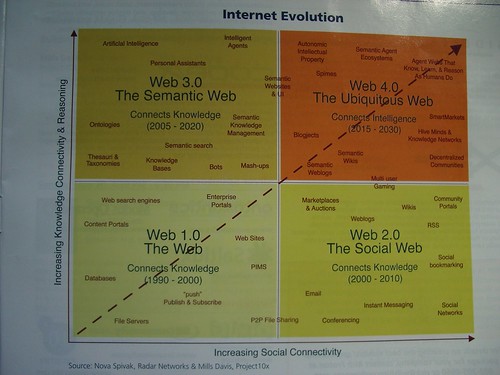I just got a pamphlet inviting me to the 2007 Semantic Technology conference, which has a curious illustration on page 3.
The illustration shows the "evolution" of the Internet, really the Web, since what its creators do is show how "Web 2.0" becomes "Web 4.0." Or something. Basically, I read it as a kind of recasting of classical hard AI opportunistically in the language of modern Web development. You can see that there's an arrow that points to the upper right (connecting, somewhat confusingly, Web 1.0 and Web 4.0, while bypassing Web 2.0 and Web 3.0), which reads "Agent Webs that Know, Learn & Reason as Humans Do."
This is all happening along two primary axes, "Increasing Social Connectivity" and "Increasing Knowledge Connectivity & Reasoning." The first one is clear, it's the primary driver of the flowering of Web 2.0: people are social, so the information they use can be social, too. The second one seems reasonable as a label--yes, we are increasing in the amount of data that's available to us, so we're probably increasing the amount of knowledge. "Reasoning," however, assumes a lot. If you look at the Web 1.0 and Web 2.0 clusters, I don't know if "Enterprise Portals" actually exhibit any appreciably more more "reasoning" than "Databases," as the graph seems to imply.
But this is nitpicking. The interesting thing for me about this graph is how it misses specialized devices almost entirely. "Blogjects" and "Spimes" show up in Web 4.0, yet mobile phones don't show up in Web 1.0/2.0 at all, much less fuzzy logic rice makers. My biases are well known, but if we're to read the projected dates, it appears that "Artificial Intelligence" will show up before ubicomp. I think that's wishful thinking. AI has been 10 years away for 50 years. Devices that employ a limited understanding of semantic relationships between objects in the world are much more likely to appear before reasoning "Intelligent agents" or "bots" and they will look little like top-down models of human cognition. They're going to be like the Roomba, much closer to insects, and behaving as "irrationally" as insects do while functioning much more effectively than systems that try to reason. They will most definitely be part of the evolution of the Internet, too, but it'll be the Internet of things, which will project the Semantic Web into everyday life, rather than leaving it inside some networked abstraction, as I feel this chart implies.




